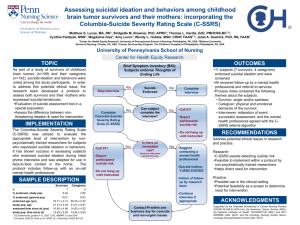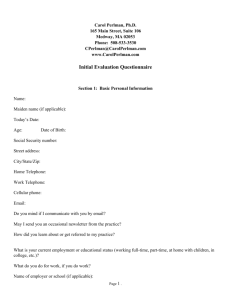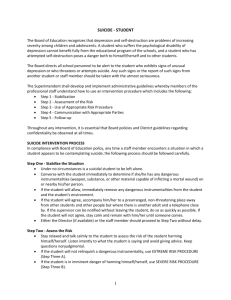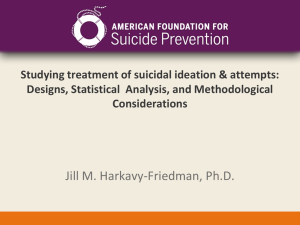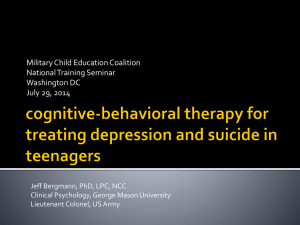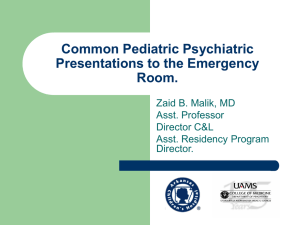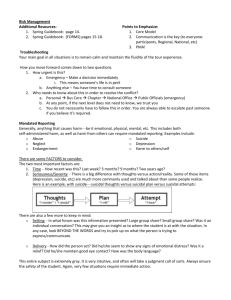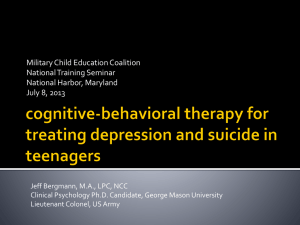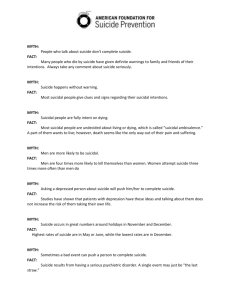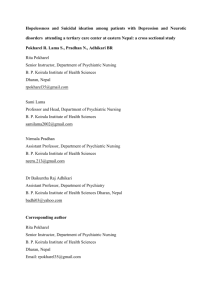Crisis Interventions for Suicidal Behavior
advertisement
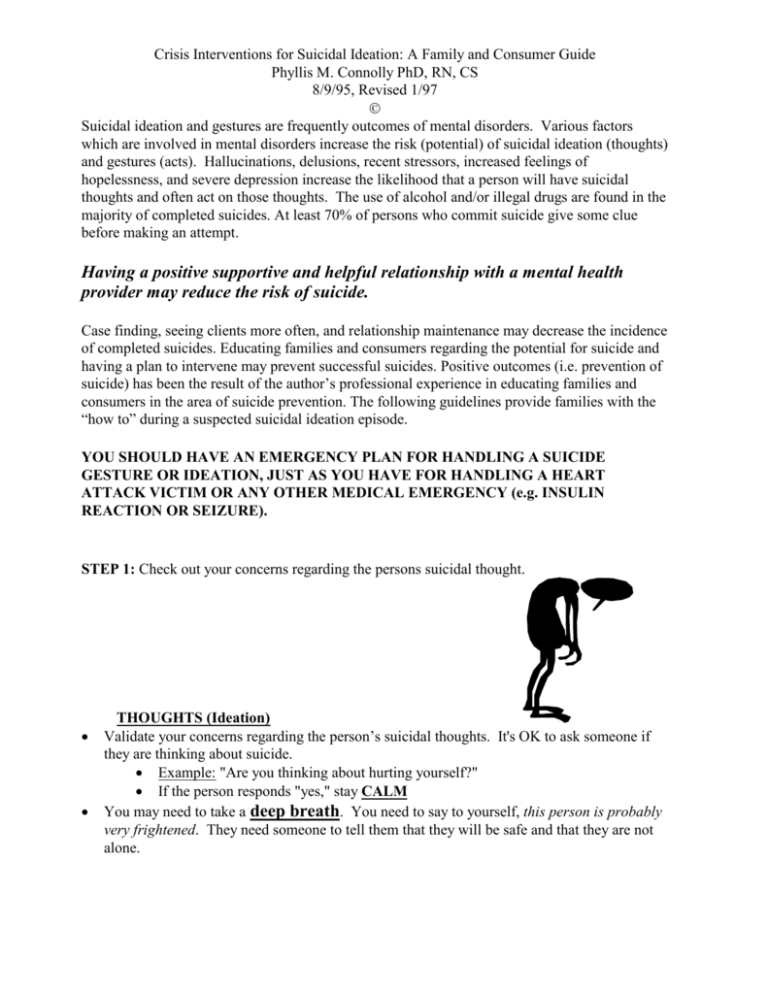
Crisis Interventions for Suicidal Ideation: A Family and Consumer Guide Phyllis M. Connolly PhD, RN, CS 8/9/95, Revised 1/97 Suicidal ideation and gestures are frequently outcomes of mental disorders. Various factors which are involved in mental disorders increase the risk (potential) of suicidal ideation (thoughts) and gestures (acts). Hallucinations, delusions, recent stressors, increased feelings of hopelessness, and severe depression increase the likelihood that a person will have suicidal thoughts and often act on those thoughts. The use of alcohol and/or illegal drugs are found in the majority of completed suicides. At least 70% of persons who commit suicide give some clue before making an attempt. Having a positive supportive and helpful relationship with a mental health provider may reduce the risk of suicide. Case finding, seeing clients more often, and relationship maintenance may decrease the incidence of completed suicides. Educating families and consumers regarding the potential for suicide and having a plan to intervene may prevent successful suicides. Positive outcomes (i.e. prevention of suicide) has been the result of the author’s professional experience in educating families and consumers in the area of suicide prevention. The following guidelines provide families with the “how to” during a suspected suicidal ideation episode. YOU SHOULD HAVE AN EMERGENCY PLAN FOR HANDLING A SUICIDE GESTURE OR IDEATION, JUST AS YOU HAVE FOR HANDLING A HEART ATTACK VICTIM OR ANY OTHER MEDICAL EMERGENCY (e.g. INSULIN REACTION OR SEIZURE). STEP 1: Check out your concerns regarding the persons suicidal thought. THOUGHTS (Ideation) Validate your concerns regarding the person’s suicidal thoughts. It's OK to ask someone if they are thinking about suicide. Example: "Are you thinking about hurting yourself?" If the person responds "yes," stay CALM You may need to take a deep breath. You need to say to yourself, this person is probably very frightened. They need someone to tell them that they will be safe and that they are not alone. Crisis Intervention: Family and Consumer Guidelines: Suicidal Ideation 2 Phyllis M. Connolly PhD, RN, CS If possible, ask the person what their thoughts are like (you want to know if they are hearing voices which may be giving them commands to kill themselves). If "yes," get the person to the suicide crisis center or emergency psychiatric services immediately. STEP 2: If there are no voices, ask for details about how they expect to kill (hurt) themselves. This helps establish if there is a plan. What exactly do they intend to do? For example, do they intend to use a gun (firearms account for 60% of all suicides across all ages). Does the person have access to a gun or medications, whatever the method? How specific is the person’s plan? Do they intend to use the method today or is the plan to use the method only if a social security check does not arrive by Friday, and today is Monday? If the person’s plan is lethal, concrete, specific, and available, get the person to the suicide crisis center or emergency psychiatric services. STEP 3: If the person has no plan or if it is not specific, available, or immediate, then proceed with the following questions about medications. Ask about what medications and the dosage which may have been taken in the last 24 hours. This will help determine if the suicidal ideation (thoughts) might be related to a drop in the therapeutic level of a prescribed medications or possibly to an interaction between a prescribed medication and an over the counter medication. STEP 4: The person should be seen by a mental health professional as soon as possible. If possible, the person should be seen by their primary therapist. If not, call the SUICIDE & CRISIS HELP LINE 408-279-3312 (in Santa Clara County, CA) or your local CRISIS HELP LINE. As in any other EMERGENCY, someone should stay with the person at all times. Generally, the person is experiencing very strong feelings of abandonment, loneliness, guilt, and hopelessness. Crisis Intervention: Family and Consumer Guidelines: Suicidal Ideation 3 Phyllis M. Connolly PhD, RN, CS ASSESSMENT AT THE CRISIS CENTER PRIMARY THERAPIST Hospitalization Depending on the outcome of the assessment of the crisis staff or therapist the person may need a brief hospitalization. The person may be placed on a 5150 (72 hour hold) (California) if they are assessed to be a grave danger to themselves or others. In some situations, the person may voluntarily admit themselves to an inpatient unit. In Home Support Depending on the person's suicide risk and the community resources available, they may be sent home. If the person is not hospitalized they should not be left alone. Someone needs to be available at all times. The person most likely will be asked to agree to let their support person and therapist know if the suicidal thoughts are increasing or if they feel that they cannot control a suicidal gesture. Establishing a Support System Friends, church members, family members, and roommates can often be enlisted to provide a supportive environment. Medications Medications may be prescribed to control the suicidal thoughts. Most likely only small amounts will be dispensed so the person does not have access to use extra medications in an overdose attempt. This may not even be an intentional overdose; frequently, people are confused and disoriented and actually forget how much medication they took or if they took their medications at all. Identifying Precipitating Factors It's important once the person is safe and secure to attempt to find out if there were recent stressors such as changes, losses, or anticipated losses that could be related to the increase in suicidal ideation/gestures. The mental health professional will assess additional factors such as an impending relapse, an increase in depression, nutritional imbalances, medications, physiological changes, or medical conditions. Adaptive Problem Solving Frequently persons who express suicidal ideation and/or gestures have reduced basic problem solving skills. It's imperative to assist the person with basic problem solving. This begins with the basics: Where are they living? Do they have food and basic survival needs? What has worked in the past for this person? The person may need support and direction with handling activities of daily living. Family can be instrumental and provide a basic critical component in reestablishing the person's equilibrium. Crisis Intervention: Family and Consumer Guidelines: Suicidal Ideation 4 Phyllis M. Connolly PhD, RN, CS Competency and Efficacy Facilitate the person's sense of competency and efficacy Set short term goals which can be met Example: establish a verbal or written contract that the person will not act on the suicidal thoughts for 24 hours Encourage and give positive feedback for meeting that goal Family and support persons are critical in identifying and giving the person positive reinforcement for those actions which the person is able to do. This may mean praising the person for seeking help, accepting the help, and agreeing to stay with family for support. Facilitate Feelings of Hope Provide a supportive climate Facilitate hopeful perception Help the person to restructure the situation Assist the person in making plans Assist the person in taking action, and establishing goals for living Get the person to the nearest hospital emergency department. Follow your emergency plan, call 911. SUICIDE GESTURES(Acts) If at all possible stay with the person at all times, unless somehow you have been targeted as the person who may have failed to meet the suicidal person's expectations or needs. This may be an actual or a distorted perception of the suicidal person. Treatment from this point will depend on the nature and seriousness of the suicide gesture. The person will need tremendous support. If the person has actually been unsuccessful in their attempt to end their life, their depression, hopelessness, and possibly anger may be very intense. STAY CALM. GET SUPPORT AND COUNSELING FOR YOURSELF AFTER THE PERSON HAS BEEN STABILIZED. YOU CAN GET SUPPORT FROM AN ALLIANCE FOR THE MENTALLY ILL (AMI) CARING/SHARING MEETING OR YOUR OWN COUNSELOR. 800-950-6264 Crisis Intervention: Family and Consumer Guidelines: Suicidal Ideation 5 Phyllis M. Connolly PhD, RN, CS Selected Bibliography Aguilera, D. C. (1994 ). Crisis intervention: Theory and methodology (7th ed.).St. Louis: Mosby-Year Book. Babcock, D., & Miller, M. (1994). Client education: Theory and practice. St. Louis: MO. Bernheim, K. (1990). Promoting family involvement in community residences for chronic mentally ill persons.; Hospital and Community Psychiatry, 41(6), 668-670. Campinha-Bacote, J. (1994). Cultural competence in psychiatric mental health nursing: A conceptual model. Nursing Clinics of North America, 29(1), 1 - 9. Cowan, C. F., & Bowie-Guillory, J. A. (1995). Teaching patients with low literacy skills In B. Fuszard, Innovative teaching strategies in nursing 2nd ed.) (pp. 231 - 241). Gaithersbrg, MD: Aspen. Depression Guideline Panel (1993). Depression in primary care: Volume 1, Diagnosis and detection. Clinical practice guideline, Number 5. Rockville, MD. U. S. Department of Health and Human Services, Public Health Service, Agency for Health Care Policy and Research. AHCPR Publication No. 93-0550. Depression Guideline Panel (1993). Depression in primary care: Volume 2, Treatment of Major Depression. Clinical practice guideline, Number 5. Rockville, MD. U. S. Department of Health and Human Services, Public Health Service, Agency for Health Care Policy and Research. AHCPR Publication No. 93-0551. Falvo, D. (1994). Effective patient education (2nd ed.). Gaithersburg, MD: Aspen. Fuszard, B. (1995). Innovative teaching strategies in nursing (2nd ed.). Gaithersburg, MD: Aspen. Hatton, C., & Valente, S. (1984). Suicide: Assessment and intervention (2nd ed.). Norwalk, CT: Appleton-Century-Crofts. Hoff, L. (1995). People in crisis: Understanding and helping (4th ed.). San Francisco: Jossey-Bass Publishing. Jack, R. (1992). Women and attempted suicide. Hillsdale, NJ: Lawrence Erlbaum Associates, Publishers. Knowles, M. S. (1980). The modern practice of adult education: From pedagogy to andragogy (2nd ed.). New York: Cambridge University Press. Crisis Intervention: Family and Consumer Guidelines: Suicidal Ideation 6 Phyllis M. Connolly PhD, RN, CS Moller, M., & Wer, J. (1989). Simultaneous patient/family education regarding schizophrenia: The Nebraska model. Archives of Psychiatric Nursing, 3(6) 332-337. Orem, D. E. (1991). Nursing: Concepts of practice (4th ed.). St. Louis: Mosby-Year Book. Palmer-Erbs, V. K., & Anthony, W. (1995). Incorporating psychiatric rehabilitation principles into psychiatric-mental health nursing practice: An opportunity to develop a full partnership among nurses, consumers, and families. Journal of Psychosocial Nursing and Mental Health Services, 33(3), 36-44. Parker, B. (1993). Living with mental illness: The family as caregiver. Journal of Psychosocial Nursing and Mental Health Services ,31(3), 19-21. Peternelj-Taylor, Hartley, V. (1993). Living with mental illness: Professional/Family collaboration. Journal of Psychosocial Nursing and Mental Health Services, 31(3), 23-28. Silverman, M., & Maris, R. (Eds.). (1995). Suicide prevention toward the year 2000. New York: Guilford Press. Trigoboff, E. (1996). Through patients' eyes: Medication teaching to reduce psychiatric recidivism. Capsules & Comments in Psychiatric Nursing, 3(1), 9 - 13.
